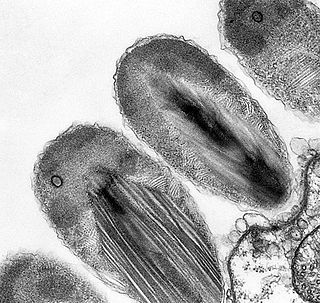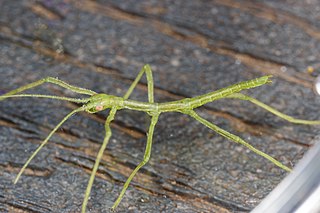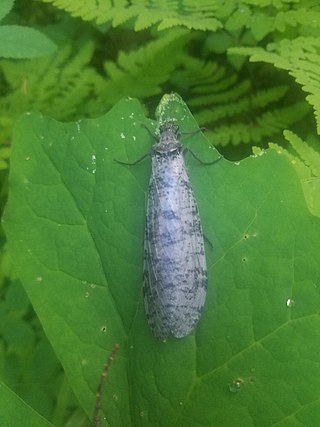
Genus is a taxonomic rank above species and below family as used in the biological classification of living and fossil organisms as well as viruses. In binomial nomenclature, the genus name forms the first part of the binomial species name for each species within the genus.

The acouchis are rodents belonging to the family Dasyproctidae from the Amazon basin. They are generally smaller than agoutis and have very short tails, while agoutis lack tails. For this reason the acouchis are also called tailed agoutis.

Verrucomicrobiota is a phylum of Gram-negative bacteria that contains only a few described species. The species identified have been isolated from fresh water, marine and soil environments and human faeces. A number of as-yet uncultivated species have been identified in association with eukaryotic hosts including extrusive explosive ectosymbionts of protists and endosymbionts of nematodes from genus Xiphinema, residing in their gametes. The verrucomicrobial bacterium Akkermansia muciniphila is a human intestinal symbiotic bacterium that is considered as a promising probiotic.

Diapheromerinae is a subfamily of the stick insect family Diapheromeridae. They belong to the superfamily Anareolatae of suborder Verophasmatodea.

Hesperoperla is a genus of common stoneflies in the family Perlidae. There are at least two described species in Hesperoperla.

Peripsocus is a genus of stout barklice in the family Peripsocidae. There are more than 250 described species in Peripsocus.

Megaphasma denticrus, the giant walkingstick, is a species of phasmid or stick insect in the family Diapheromeridae. It is the largest insect in North America, growing up to 7 inches in length.
Apote is a genus of shield-backed katydids in the family Tettigoniidae. There are at least two described species in Apote.
Nisoscolopocerus is a genus of leaf-footed bugs in the family Coreidae. There are at least two described species in Nisoscolopocerus.

Chimarra is a genus of little black caddisflies in the family Philopotamidae. There are more than 630 described species in Chimarra.

Dysmicohermes is a genus of fishflies in the family Corydalidae. There are at least two described species in Dysmicohermes.

Chilacis is a genus of true bugs in the family Artheneidae. There are at least two described species in Chilacis.
Ereminellus is a genus of dirt-colored seed bugs in the family Rhyparochromidae. There are at least two described species in Ereminellus.
Syntrichalonia is a genus of exquisite long-horned bees in the family Apidae. There are at least two described species in Syntrichalonia.
Cnemodus is a genus of dirt-colored seed bugs in the family Rhyparochromidae. There are at least two described species in Cnemodus.
Burtinus is a genus of broad-headed bugs in the family Alydidae. There are at least two described species in Burtinus.

Paracyrtophyllus is a genus of western true katydids in the family Tettigoniidae. There are at least two described species in the genus Paracyrtophyllus.

Cligenes is a genus of dirt-colored seed bugs in the family Rhyparochromidae. There are at least two described species in Cligenes.
Anconia is a genus of band-winged grasshoppers in the family Acrididae. There are at least two described species in Anconia.

Menecles is a genus of stink bugs in the family Pentatomidae. There are at least two described species in Menecles.













